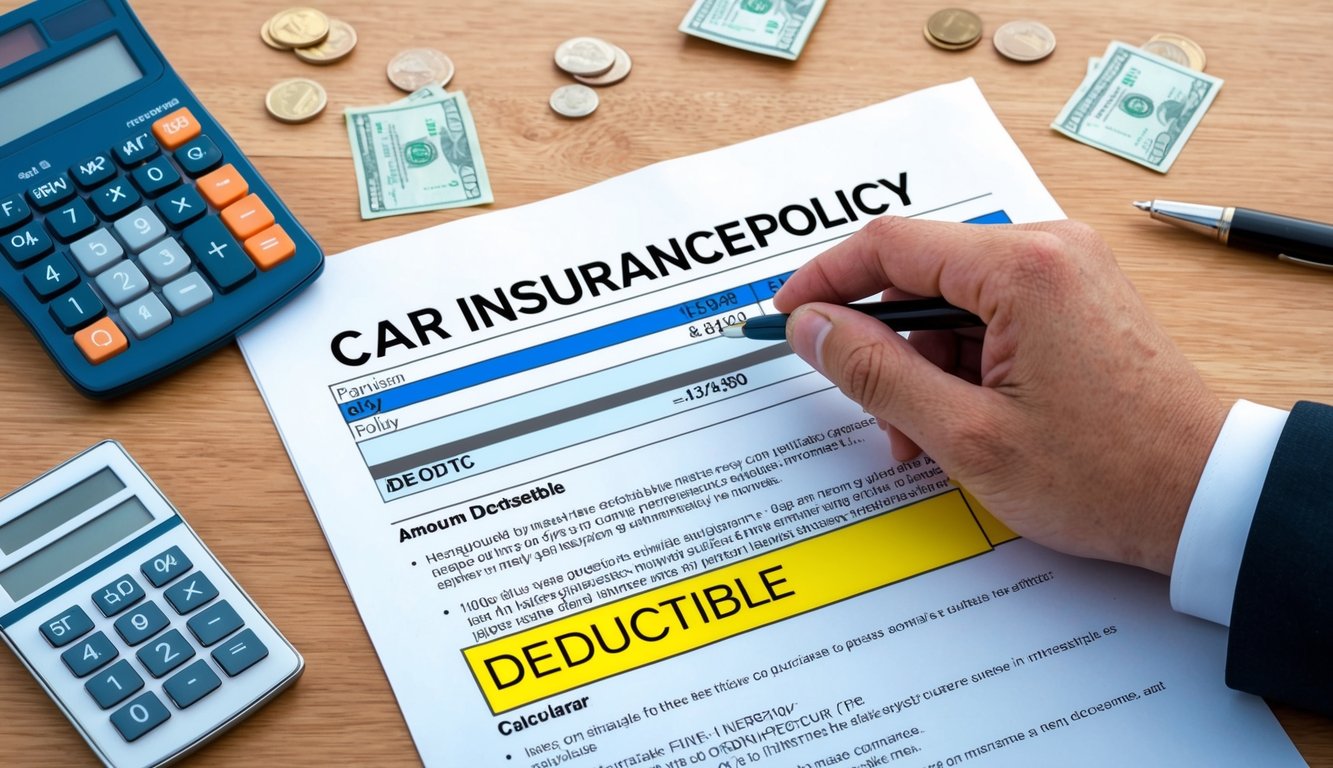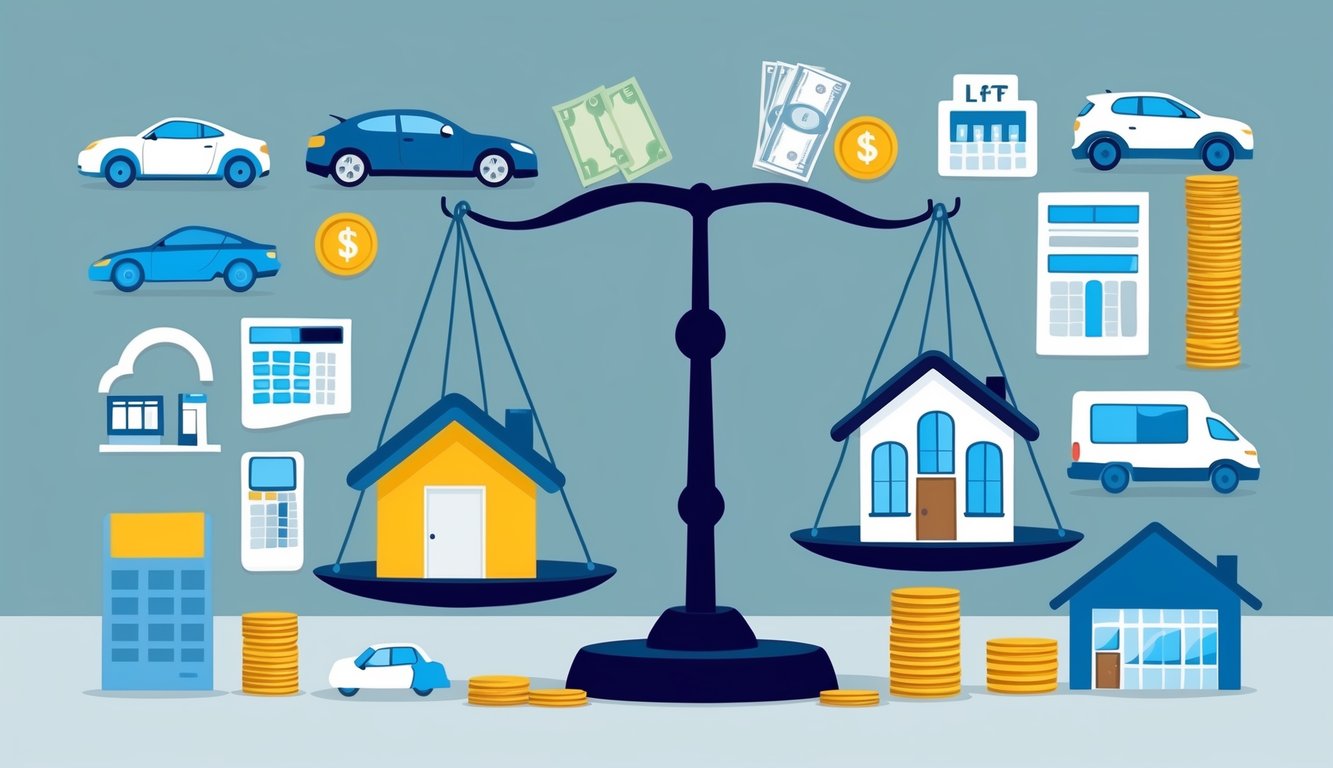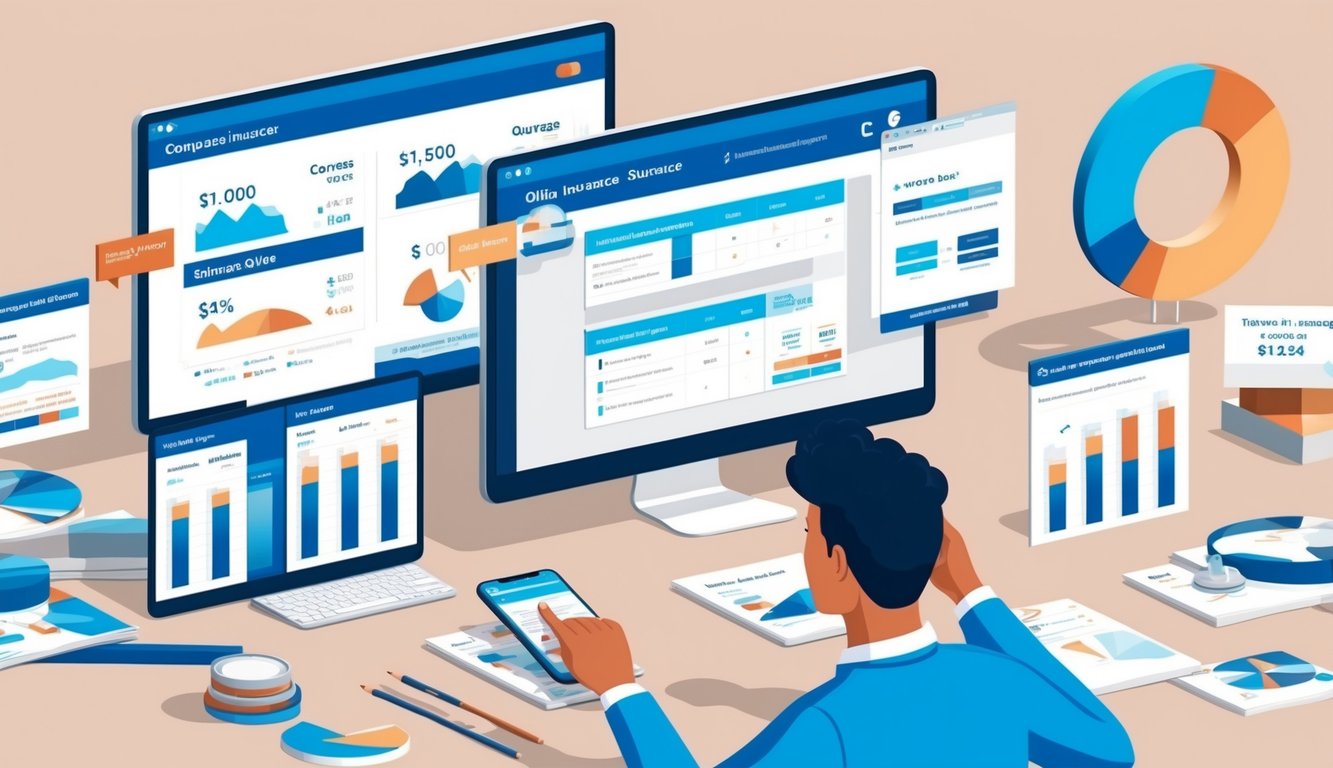Car insurance is a necessary expense for drivers, but it doesn’t have to break the bank.
Many people assume that lowering their insurance costs means sacrificing important coverage.
However, this is not always the case.
You can find ways to reduce your car insurance premiums while maintaining adequate protection for your vehicle and yourself. By exploring various strategies and understanding the factors that influence insurance rates, you can potentially save money without compromising on essential coverage.
Let’s examine some effective methods to achieve more affordable car insurance.
1) Increase Your Deductible

Raising your deductible is a simple way to lower your car insurance premiums.
Your deductible is the amount you pay out of pocket before your insurance coverage kicks in.
By choosing a higher deductible, you can reduce your premium costs significantly.
For example, increasing your deductible from $200 to $500 could cut your collision and comprehensive coverage expenses by 15% to 30%.
Consider your financial situation when deciding on a deductible increase.
Make sure you can comfortably afford the higher amount in case you need to file a claim.
Increasing your deductible from $500 to $1,000 could result in additional savings of up to 31%.
This strategy allows you to keep your coverage levels intact while reducing your monthly or annual insurance costs.
Remember to weigh the potential savings against the increased out-of-pocket expense.
If you’re a safe driver with a good record, a higher deductible might be a smart choice to lower your insurance costs.
2) Shop Around for Quotes

Getting cheaper insurance starts with comparing rates from multiple providers.
Don’t assume your current insurer offers the best deal.
Insurance companies use different formulas to calculate premiums, so prices can vary significantly.
Compare quotes from at least three different insurance companies.
Look for insurers that specialize in your demographic or vehicle type.
Some may offer better rates for your specific situation.
Use online comparison tools to quickly get quotes from multiple insurers.
These tools make it easy to input your information once and receive estimates from several companies.
Request quotes every 6-12 months.
Insurance rates change frequently, so regularly checking for better deals can lead to significant savings.
When comparing quotes, ensure you’re looking at policies with similar coverage levels and deductibles.
This allows for an accurate comparison of rates.
Don’t forget to ask about discounts.
Many insurers offer reduced rates for safe driving, bundling policies, or installing safety features in your vehicle.
Consider working with an independent insurance agent.
They can access quotes from multiple companies and help you find the best coverage at competitive rates.
3) Bundle Your Policies
Bundling your insurance policies is a smart way to save money without compromising coverage.
By combining multiple policies with one insurer, you can unlock significant discounts.
Most insurance companies offer bundling options for home and auto insurance.
This combination is particularly popular and can lead to savings of 6% to 23%, depending on the insurer.
You can often bundle other types of coverage as well.
Consider combining your auto, home, and life insurance policies for even greater savings.
When exploring bundling options, start by contacting your current insurance provider.
Ask about available discounts for combining policies you already have or adding new ones.
Don’t forget to shop around and compare quotes from different insurers.
You might find better bundle deals elsewhere, potentially saving you more money.
Keep in mind that bundling isn’t just about savings.
It can also simplify your insurance management by consolidating your policies under one provider.
Before deciding to bundle, carefully review the coverage offered in each policy.
Ensure that the combined package meets all your insurance needs without any gaps in protection.
If you’re considering a switch, evaluate whether the bundling savings outweigh any cancellation fees or loyalty discounts you might lose with your current insurer.
4) Improve Your Credit Score
Your credit score can significantly impact your insurance rates.
Many insurers use credit-based insurance scores to determine premiums, as they believe these scores correlate with the likelihood of filing claims.
Improving your credit score can lead to lower car insurance premiums.
Start by paying bills on time and reducing your overall debt.
These actions demonstrate financial responsibility to insurers.
Keep your credit card balances low.
High credit utilization can negatively affect your score.
Aim to use less than 30% of your available credit limit.
Regularly check your credit report for errors.
Dispute any inaccuracies you find, as they could be unfairly lowering your score and increasing your insurance costs.
Avoid opening new credit accounts unnecessarily.
Each application can result in a hard inquiry on your credit report, potentially lowering your score temporarily.
If you live in certain states, your credit score may have less impact on your insurance rates. California, Hawaii, Massachusetts, Maryland, Oregon, Utah, and Michigan have laws limiting or prohibiting the use of credit scores in determining insurance premiums.
Be patient.
Improving your credit score takes time, but the potential savings on your insurance premiums can be substantial.
Keep monitoring your score and maintaining good financial habits.
5) Ask About Discounts
Insurance companies offer various discounts that can significantly reduce your premiums.
Take the initiative to inquire about available discounts when shopping for car insurance.
Many insurers provide multi-policy discounts if you bundle your auto insurance with other policies like homeowners or renters insurance.
This can lead to substantial savings on both policies.
Safe driving discounts are common.
If you have a clean driving record without accidents or traffic violations, you may qualify for lower rates.
Some companies also offer discounts for completing defensive driving courses.
Ask about discounts for vehicle safety features.
Anti-theft devices, airbags, and automatic braking systems can often lead to reduced premiums.
Insurance companies appreciate these features as they lower the risk of claims.
Students with good grades may be eligible for discounts.
If you or a family member maintains a high GPA, mention this to your insurance provider.
Low-mileage discounts are available for drivers who don’t use their cars frequently.
If you work from home or have a short commute, you might qualify for reduced rates.
Many insurers offer discounts for setting up automatic payments or paying your premium in full.
These options can lead to noticeable savings over time.
Don’t hesitate to ask about profession-based discounts.
Some companies offer lower rates for certain occupations like teachers, military personnel, or first responders.
6) Maintain a Clean Driving Record
Keeping a clean driving record is one of the most effective ways to lower your car insurance premiums.
Insurance companies view drivers with clean records as less risky, and they reward this behavior with lower rates.
To maintain a clean driving record, always obey traffic laws and drive defensively.
Avoid speeding, running red lights, or engaging in other risky behaviors that could lead to citations or accidents.
If you do receive a ticket, consider taking a defensive driving course.
Many states allow you to remove minor violations from your record by completing these courses.
Pay attention to your surroundings while driving and anticipate potential hazards.
This can help you avoid accidents, which can significantly impact your insurance rates.
Never drive under the influence of alcohol or drugs.
DUI convictions can drastically increase your insurance costs for years.
If you have teenage drivers in your household, encourage them to maintain clean records as well.
Their driving behavior can affect your family’s overall insurance rates.
Remember that most violations stay on your record for at least three years. Serious offenses like DUIs or reckless driving can impact your rates for even longer.
Understanding Insurance Costs

Insurance premiums are influenced by various factors and coverage types.
Knowing these elements can help you make informed decisions about your policy.
Factors Affecting Premiums
Your driving record plays a crucial role in determining insurance costs. Accidents and traffic violations can lead to higher premiums.
Age and experience also impact rates, with younger drivers often paying more.
Vehicle type affects pricing.
Expensive or high-performance cars typically cost more to insure.
Your location matters too – urban areas with higher accident rates may result in pricier policies.
Credit score can influence premiums in many states.
Better credit often leads to lower rates.
Annual mileage is another factor – the more you drive, the higher your risk exposure.
Deductible choice impacts your premium. Opting for a higher deductible can lower your monthly costs but increases out-of-pocket expenses if you file a claim.
Types of Coverage
Most states require liability coverage.
It protects you financially if you’re at fault in an accident.
Meanwhile, collision coverage pays for damage to your car from accidents.
On the other hand, comprehensive coverage handles non-collision incidents like theft or natural disasters.
Personal injury protection covers medical expenses for you and your passengers.
Uninsured/underinsured motorist coverage protects you if the at-fault driver lacks sufficient insurance.
Optional coverages include rental car reimbursement and roadside assistance.
Gap insurance can be valuable for leased or financed vehicles.
It covers the difference between your car’s value and the amount owed.
Strategies to Lower Your Insurance Premiums

Reducing your insurance costs doesn’t have to mean sacrificing coverage.
By being proactive and strategic, you can maintain robust protection while keeping more money in your pocket.
Comparison Shopping
Shopping around is one of the most effective ways to find lower insurance rates.
Don’t assume your current provider offers the best deal.
Get quotes from at least 3-5 different insurers to compare prices and coverage options.
Use online comparison tools to quickly gather quotes from multiple companies.
Pay attention to coverage limits and deductibles when comparing policies.
A lower price isn’t always better if it means less protection.
Consider working with an independent insurance agent.
They can shop multiple carriers for you and help identify the best combination of coverage and price.
Don’t forget to reassess your insurance needs periodically.
Your circumstances may change, making you eligible for new discounts or different coverage options.
Bundling Policies
Combining multiple insurance policies with one company can lead to significant savings.
Many insurers offer multi-policy discounts when you bundle your coverage.
Common bundles include:
- Auto and homeowners/renters insurance
- Auto and life insurance
- Home and umbrella policies
Bundling can save you 5-25% on your premiums, depending on the insurer and policies combined.
It also simplifies your insurance management by reducing the number of companies you deal with.
When considering bundling, get quotes for both bundled and separate policies.
In some cases, you might save more by using different insurers for different types of coverage.
Remember, convenience shouldn’t trump savings.
Always compare the bundled price to the cost of purchasing policies separately from different insurers.
Maximizing Coverage Efficiency

Optimizing your insurance coverage involves carefully examining your policies and understanding key components.
By taking a proactive approach, you can ensure you’re getting the most value for your premium dollars.
Reviewing and Updating Policies
Take time to review your insurance policies annually.
As your life circumstances change, so do your coverage needs.
Check for any outdated information or unnecessary coverages.
Remove any duplicate coverages across different policies.
For example, you may have roadside assistance through both your auto insurance and a separate service.
Look for potential gaps in coverage and address them.
You might need additional protection for valuable items or new risks.
Consider bundling policies with one insurer.
Many companies offer discounts for multiple policies, which can lead to significant savings.
Ask your insurer about any new discounts you may qualify for.
Safe driving records, home security systems, or good credit scores can often reduce your premiums.
Understanding Deductibles
Your deductible is the amount you pay out of pocket before your insurance kicks in.
Choosing the right deductible can significantly impact your premiums and coverage efficiency.
Higher deductibles generally lead to lower premiums.
If you have a solid emergency fund, consider raising your deductible to reduce monthly costs.
Calculate your potential savings from a higher deductible against the increased out-of-pocket expense in case of a claim.
This helps you find the sweet spot for your financial situation.
Some insurers offer disappearing deductibles.
These decrease over time if you remain claim-free, providing long-term savings and improved coverage.
Remember, the ideal deductible balances affordability with your ability to pay in case of an incident.
Don’t set it so high that you’d struggle to cover it when needed.






